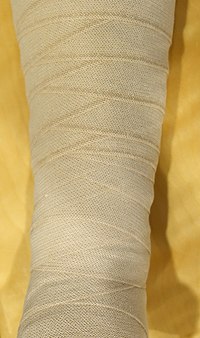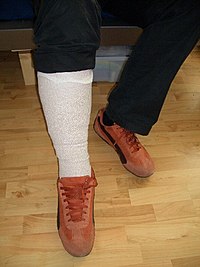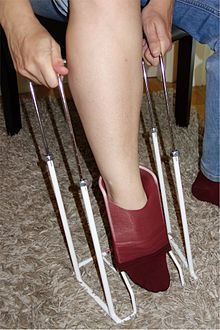Compression therapy
The compression therapy is a form of therapy by local pressure on the venous leg vascular system leads to an increase of the flow velocity of the blood. This pressure can be created by bandaging the leg with compression bandages or by using special stockings. Compression therapy is used for various clinical pictures.
aims
The venous leg vessels are narrowed by developing and ensuring permanent pressure. This increases the speed of blood flow . The return flow to the heart increases, edema is reduced and pain is reduced. Other desirable effects are the acceleration of the healing of possible wounds, the prevention of recurrences and thromboses and thus ultimately an increase in the patient's quality of life .
Areas of application
Compression therapy is used for a variety of clinical pictures and pathological conditions:
- Chronic venous insufficiency
- Post-thrombotic syndrome
- primary and secondary lymphedema
- primary and secondary varicosis
- Thrombophlebitis
- deep vein thrombosis
- Edema of pregnancy
- after stripping or obliterating the varices
- cyclic and idiopathic edema
- Angiodysplasia
In addition, compression therapy is also used preventively in diseases where there is a risk of thrombosis and in immobile patients who develop congestion, such as B. paresis or partial paresis of the legs.
Compression and movement
Compression therapy reduces the volume of those blood-carrying vessels in the body that are below the compression bandage. In a physical way, the blood flow speed increases because it has less space to pass. The proper movement of the body is decisive for the flow speed and thus for the success of the compression therapy, because the tension in the muscles of the leg increases the blood flow. The patient should be fully informed about these aspects, among other things in order to motivate them to move with the applied compression. Understandable patient brochures that are adapted to the situation of the person concerned explain the possibilities of getting involved in compression therapy. Bedridden patients can perform gymnastic exercises such as foot circles, ball of the toes, or rocking feet. Compression therapy reduces pain as well as tissue swelling and the formation of edema. The so-called 3-S, 3-L rule , which says: "Sitting and standing is bad, it is better to walk and lie down," applies as a mnemonic.
Materials and forms of supply
Compression can be ensured both by wrapping bandages and by putting on stockings that have been specially developed for this purpose and are made to measure or match the patient's dimensions. The pressure generated differs in working and resting pressure.
Working pressure Is the result of the resistance that the bandage opposes the expansion of the muscles during muscle contraction , i. H. when the leg starts to move and the more inelastic the compression, the higher it is. Idle
pressure corresponds to the system pressure, i.e. H. the force that has to be used to stretch the bandage when it is put on is also influenced by the individual resilience of a bandage
Long-stretch bandages - These bandages have a very high elasticity of up to twice their own length. They generate a low working pressure, but a high resting pressure. This is usually not desired in the case of venous diseases. Therefore, long-stretch bandages are rarely used in phlebology (vein medicine). With long-stretch bandages there is also the risk that immobile patients will develop significant constrictions, which is why they are no longer used in these patients in particular.
Short-stretch bandages - short-stretch bandages are made of inelastic textile and therefore only have a very low elasticity. They enable the high working pressure and low resting pressure desired in venous diseases. Short-stretch bandages are the bandages of choice for mobile patients, e.g. B. with phlebitis, after a vein operation or with an open leg (ulcus cruris).
Zinc glue bandages - The textile fabric of the zinc glue bandages is enriched with glue, which hardens when the damp bandage dries. The hardening creates the compression pressure. If the leg circumference decreases, it decreases accordingly. A zinc glue bandage must be changed daily.
Binding systems - manufacturers offer ready-made multi-layer systems that contain compression, fixation and padding. To apply such a compression it is not necessary to have knowledge of extensive wrapping techniques.
Compression stockings - There are two types of compression stockings , which differ in the type of knitting. Flat-knitted compression stockings with seams as well as single- and double-faced round-knitted seamless stockings.
Stocking systems - The stocking systems for compression therapy usually consist of two components, an under and over stocking . The compression pressure of the understocking is lower than that of the overstocking; both pressures add up. The liner remains on the patient's leg overnight. The liner is only put on over it during the day.
Risks
Unsuitable compression stockings or improper wraps can cause skin damage, which can lead to lacerations, blisters, pressure points and necrosis. In addition, nerve damage or deep vein thrombosis can develop.
Apply compression
The following describes compression therapy with sanitary towels. At the beginning of the system, a tubular bandage is put on, which on the one hand prevents the wrap and the padding from lying directly on the skin and on the other hand fixes the wrap. The padding placed above it evens out anatomical unevenness. This is where the actual winding takes place.
Numerous application techniques have developed according to which compression bandages with short-stretch bandages can be applied. These methods each have the names of their developers, there are Sigg, Fischer, Schneider and Altenkämper associations . The best known method in Germany is the Pütter Association , which goes back to the naturopath Gustav Pütter (1907–1977). The spread of the putter association has led to the fact that "puttering" is often used synonymously to apply compression garments with short-stretch bandages, even if the relatively complex putter technique is not used. There are many variations of most investment methods. In addition to the possibility of guiding the bandages around the leg, there is also the "figure eight" technique, i.e. winding the bandage up and down every time it goes around the calf. A variant of this is the so-called "ear of corn", in which the bandages are also folded over the shin , which results in a very rigid winding.
The superiority of one type of investment or variant over the others has not been scientifically proven. The following principles should be observed for every system:
Applying the hose
bandage A hose bandage made of elastic textile that adapts to the shape of the leg is used to later fix the wrap. The tubular bandage is shortened to a length that is two and a half to three times the length of the lower leg (tip toe - heel - knee). It is pulled up to the knee and the protruding end is put between the patient's toes or given in the hand. Due to the posture created in this way, the patient independently supports the 90 ° position - so-called functional position - of the ankle.
Padded
padding A bandage made of foam or padding is rolled off the leg over the tubular bandage. Such a padding bandage protects the skin of the leg from lacerations, pressure damage or allergic reactions to the bandage material. The padding begins on the back of the foot on the inside, including the metatarsophalangeal joint. The binding turns, including the heel, overlap each other by about a third or up to half and are wrapped around without tension in circular turns up to two fingers' width below the hollow of the knee. Anatomical unevenness, such as the so-called Bisgardian backdrop between the Achilles tendon and the ankle region, can also be compensated for with pads (pressure pads).
Applying the bandages
The bandage is wrapped over the padding from below the metatarsophalangeal joint of the big toe up to two fingers' width below the hollow of the knee. The bandage can, for example, overlap by half the width of the bandage and is guided with the roller close to the body. A fixing plaster holds the bandage in position at knee level. Pulling the protruding end of the tubular bandage over the wrap can give the bandage additional strength.
Padding under, up and down
In order to ensure an even pressure effect on all regions of the leg, different padding materials are used locally below the compression, in addition to the padding bandage. With individually cut pieces of foam or specially produced pads, so-called pads , unevenness is straightened out so that the compression bandage applied over it produces an even pressure. The following applies: depressions are padded and elevations are padded. Corresponding pads are used in compression therapy in particular on the shinbone , on the fibular head of the fibula or, for example to compensate for considerable calf circumferences, in the ankle region . Cushions can be placed between the cushion bandage and tubular bandage, as well as directly on the skin. These pads are also used in compression stockings, but are usually already sewn into the corresponding regions by the manufacturer.
Intermittent compression
This form of therapy is also known as intermittent pneumatic compression . With this form of supply, the compression is generated by an air cushion that surrounds the leg and, supplied by a compressor, ensures a variable pressure. The intermittent compression of the apparatus unfolds its effect through the change in pressure on the resting leg and does not require the use of the muscle pump . At the same time, it "ensures pressure relief in the resting phase and is therefore also suitable for immobile patients" . For patients with restricted mobility, it is placed over the compression bandage. A manual lymphatic drainage - carried out at regular intervals by the lymph therapists - ensures the outflow from the lymphatic system .
Adaptive compression bandages
In the initial decongestion phase, the aim is to reduce the leg circumference by reducing the edema. So-called wrap dressings can be used here. These consist of a cuff-like bandage that is placed around the lower leg and fixed with Velcro fasteners . A compression stocking is pulled over it, which only exerts a slight compression. Sometimes the foot area must also be compressed with a smaller wrap bandage. The compression pressure that the adaptive compression bandage exerts on the leg can be adjusted segmentally using the Velcro system and can be readjusted specifically, even by the patient himself.
Contraindications
Some clinical pictures require an adaptation of the compression therapy, a restricted application or even exclude it.
Circulatory situation
At the beginning of the compression therapy there is the clarification of the blood flow situation. Whether and to what extent compression is indicated depends on the type and extent of a possible arterial disorder , as this can exacerbate an existing inadequate supply of tissue. Compression increases the workload on the heart by accelerating blood circulation, particularly cardiac reflux. An already existing decompensated right heart failure is therefore an exclusion criterion for the application of a compression. Likewise the myocardial infarction or pulmonary edema .
Nerve disorders
Neuropathy reduces the sensation of pain, which is why doctors and nurses must pay special attention to compression therapy in patients with this type of disease. Ideally, a compression bandage does not create any lacing or pressure points. However, should a disproportionate constriction develop under a compression bandage, patients with neuropathy - for example caused by diabetes - will not notice the warning signals that the body sends. This then requires close-knit controls.
Other risk factors
Further risk factors or exclusion criteria (contraindications) of compression therapy are: erysipelas , weeping dermatoses , phlegmasia caerulea dolens , septic phlebitis , severe sensory disorders, intolerance to the material.
Compression pressure
In compression therapy, pressure is created by putting compression stockings or bandages on the leg, which reduces the circumference of the veins . When starting the therapy, the most exact pressure information possible is defined and not relative information, e.g. B. moderate, mild or high, strong pressure. Devices specially developed for this purpose enable the pressure generated to be reduced below the applied compression. Some binding systems have markings that are deformed to provide information about the pressure generated. More precise pressure information is only possible for compression stockings. A compression stocking or properly wound bandage is manufactured (or designed) in such a way that the pressure exerted decreases from far to near the heart - or from distal to proximal.
Compression classes
In the case of compression stockings, the pressure they guarantee defines the so-called compression class: Such stockings are available both as ready-made goods and made-to-measure.
Compression class I - the lowest application pressure of 18 to 21 mmHg is used for the prophylaxis of thrombosis, for the removal of heaviness or tiredness in the legs and is used for minor varicose veins with a low risk of edema or the beginning of varicose veins in pregnancy.
Compression class II - the medium compression develops a pressure between 23 and 32 mmHg, with pronounced varicosis of pregnancy, after variceal stripping, with swelling of the legs after healing of smaller ulcerations and as a prevention of recurrence of healed ulcers.
Compression class III - The strong compression causes a pressure of 34 to 46 mmHg, in thrombosis, secondary conditions of post-thrombotic venous insufficiency, pronounced risk of edema and dermatoliposclerosis as well as a florid venous leg ulcer .
Compression class IV - The very strong compression describes a pressure above 49 mmHg in lymphedema or elephantiasis .
The pressure that is generated by compression stockings adds up when they are pulled over each other. Patients who have difficulties putting on stockings of the higher compression classes are therefore recommended to put lower-class models on top of each other. Two compression stockings of class II placed on top of each other generate a compression pressure that corresponds to compression class IV.
Dressing aids
Donning aids protect the materials and make it easier to put on the compression stockings. They are an aid that is reimbursable by the health insurance company . Different systems are available for closed and / or open stockings. If there is no donning aid at hand, dimpled household gloves, which increase the grip, make it easier to put on the compression stockings.
literature
- Kerstin Protz, Joachim Dissemond, Knut Kröger: Compression therapy An overview for the practice. Springer Verlag, Berlin et al. 2016, ISBN 978-3-662-49743-2 .
- Stefanie Reich-Schupke, Markus Stücker: Modern Compression Therapy A practical guide. Viavital Verlag, Cologne 2013, ISBN 978-3-934371-50-7 .
- Kerstin Protz: Compression - the basis of therapeutic success. In: Special Health Professions . : "Ulcus cruris", Urban & Vogel Verlag, Munich 2008.
- EWMA position document, published by Partnership Medical Education LTD: Understanding compression therapy. London 2003.
- German Network for Quality Development in Nursing (DNQP) (Ed.): Expert standard care of people with chronic wounds. Osnabrück 2008.
- Eva Maria Panfil, Gerhard Schröder (ed.): Care of people with chronic wounds. Huber Verlag, Bern 2009.
- S2 guideline : Intermittent pneumatic compression (IPK or AIK). AWMF register number 037/007 ( full text online ), as of January 31, 2018 - valid until January 31, 2023
- S2k guidelines for medical compression therapy of the extremities with medical compression stockings (MKS), phlebological compression bandages (PKV) and medical adaptive compression systems (MAK) , AWMF , register number 037-005, ( full text online ) as of December 31, 2018 - valid until December 31 2023
Individual evidence
- ↑ a b Expert standard for the care of people with chronic wounds. DNQP (Ed.), Pp. 108-112.
- ↑ a b c Standard for compression therapy. Wundzentrum Hamburg eV 2009, p. 1f.
- ↑ EWMA position document: Understanding compression therapy. London 2003, p. 16.
- ↑ Caring for people with chronic wounds. Bern 2009, p. 261.
- ↑ Stefanie Reich-Schupke , Markus Stücker : " Modern Compression Therapy A Practical Guide ", Viavital Verlag, Cologne 2013, ISBN 978-3-934371-50-7 , page 69
- ↑ Kerstin Protz et al .: Compression bandages with and without padding: A controlled observational study on compression pressure and comfort in a dermatologist. 2018 Aug; 69 (8): 653-661. doi: 10.1007 / s00105-018-4167-9 .
- ↑ Kerstin Protz, Joachim Dissemond, Knut Kröger: Compression therapy An overview for the practice. Springer Verlag, Berlin et al. 2016, page 66 – page 67
- ↑ cit. after compression - basis of success. In: Heilbufe special. Leg Ulcer. Munich 2008.
- ↑ Caring for people with chronic wounds. Bern 2009, p. 244.
- ↑ Kerstin Protz, Joachim Dissemond, Knut Kröger: Compression therapy An overview for the practice. Springer Verlag, 2016, p. 56.
- ↑ G. Mosti, A. Cavezzi, H. Partsch, S. Urso, F. Campana: Adjustable Velcro Compression Devices are More Effective than Inelastic Bandages in Reducing Venous Edema in the Initial Treatment Phase: A Randomized Controlled Trial. In: European Journal of Vascular and Endovascular Surgery . Volume 50, number 3, September 2015, pp. 368–374, doi: 10.1016 / j.ejvs.2015.05.014 . PMID 26160211 .
- ↑ Joachim Dissemond : Compression therapy as an individualized therapy for ulcus cruris. In: vasomed. Edition 1/2016.
- ↑ a b c Compression therapy for varicose veins and chronic insufficiency. In: vascular surgery. 3, 2006.
- ^ Guidelines of the German Society for Phlebology. AWMF guidelines Reg. No. 037/009 (2008) VI.1.
- ↑ Standard for compression therapy. Wundzentrum Hamburg eV, 2009, p. 1.
- ↑ Caring for people with chronic wounds. Bern 2009, p. 229.
- ↑ Caring for people with chronic wounds. Bern 2009, p. 233.
- ↑ Stefanie Reich-Schupke, Markus Stücker (Ed.): Modern compression therapy . A practical guide. Viavital Verlag, Cologne 2013, ISBN 978-3-934371-50-7 , p. 154.
- ^ Guideline MKS of the German Society for Phlebology. See section 2.2.5. Pressure values and pressure curve.




